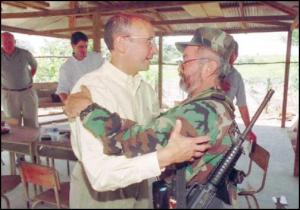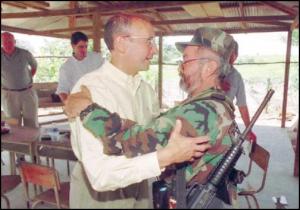U.S. Hawks Hover Over Iran
October 20, 2011 1 Comment
“It is time to take military action against the Iranian government elements that support terrorism and its nuclear program. More diplomacy is not an adequate response.” says William Kristol.
by William Echols
Global Research
October 20, 2011
Whether calls for war against Iran are meant to placate American allies in the Middle East who cannot stomach its supposed nuclear ambitions, are an attempt to reassert US dominance in the oil rich region, or are the last signs of a flagging empire lashing out in self-denial, those who are longing for it to be morning again in America might very well expedite its imperial twilight.

William Kristol in the set of Fox News one of the "official" homes of neoconservatives.
History seems to be repeating itself as the hawks who called for the 2003 overthrow of Saddam Hussein are now rattling their sabers for war against Iran. But why are those who once called for a new American Century hopelessly stuck in a bygone era?
In a bellicose diatribe published in the latest edition of the Weekly Standard, senior editor William Kristol accuses Iran of having the blood of American soldiers on its hands. Claiming that “force” is the only language the regime understands, he proceeds to call on the US Congress to “consider authorizing the use of force against Iranian entities that facilitate attacks on our troops, against IRGC (Iranian Revolutionary Guard Corps) and other regime elements that sponsor terror, and against the regime’s nuclear weapons program.”
In an October 17 Foreign Policy initiative (FPI) Bulletin, executive director Jamie Fly toes the same line, proclaiming:
“Until now, the president has chosen to be the hapless victim of Iran’s machinations. It is time for President Obama to follow in the footsteps of his predecessors and stand up to tyrants who kill Americans and threaten our interests.
“It is time to take military action against the Iranian government elements that support terrorism and its nuclear program. More diplomacy is not an adequate response.”
Speaking to Fox News on Monday, former US Ambassador to the United Nations John Bolton said it was “unfortunate” that Iran did not fear a possible military response in light of recent allegations of an Iranian assassination plot on US soil. Somewhat ironically, Bolton also described President Barack Obama’s recent decision to send 100 troops to stem off a humanitarian crisis in Central Africa as “damaging to our efforts to preserve our military budget.”
It is little wonder that Iranian President Mahmoud Ahmadinejad asserts the latest accusations that Iran sought to assassinate the Saudi ambassador to the US was eerily reminiscent of the weapons of mass destruction claims which provided the casus belli for the 2003 invasion of Iraq.
“In the past the US administration claimed there were weapons of mass destruction in Iraq. They said it so strongly, they offered and presented documentation and everyone said ‘yes, we believe in you, we buy it’,” Ahmadinejad said in a live interview on Al Jazeera television.
Ahmadinejad’s cause for alarm might seem justified under the circumstances. Ever since George W. Bush’s January 29, 2002 State of the Union Address, wherein Iran (along with Iraq and North Korea) were labeled as the “Axis of Evil”, neo-conservative policy wonks and senior-level government officials have had the country in their sights. And much like Iraq, the case for war is as mercurial and adaptive as the public opinion it caters to.
Kristol for his part was one of the key proponents for regime change in Iraq, outlining the case in a 2003 book he co-authored entitled The War Over Iraq: Saddam’s Tyranny and America’s Mission. But his desire to effect regime change in the Middle East has earlier roots.
In a 1996 Foreign Affairs article, William Kristol, challenging what he believed was “a tepid consensus that accepts decline of US power in the world as inevitable,” called for a neo-Reaganite foreign policy which would pursue “benevolent hegemony” and “wield its authority unabashedly.”
By June 1997, William Kristol, along with several other prominent neo-conservatives who would have high-level administrative positions in the Bush administration (including Dick Cheney, Paul Wolfowitz, Donald Rumsfeld and Elliot Abrams), not to mention his brother Jeb Bush, signed off on a statement of principles intended to usher in this halcyon era of American military strength and moral clarity. This statement of principles would come to define the Project for a New American Century.
The four key principles called for increased defense spending and force modernization, the strengthening of ties with democratic allies and the willingness to confront regimes hostile to American interests, the promotion of political and economic freedom abroad, and the “need to accept responsibility for America’s unique role in preserving and extending an international order friendly to our security, our prosperity, and our principles.”
Subsequently, on January 26, 1998, the group sent a letter to then-President Bill Clinton urging his administration to implement “a strategy for removing Saddam’s regime from power.”
The history of what happened when a sympathetic Bush administration coupled with the tragic events of 9/11 provided the pretext for implementing this neo-Reaganite foreign policy is well-trodden territory. The question is, why are they doing it again?
On most counts, the allegations against Iran seem to defy logic. Writing for Time Magazine, former CIA field officer Robert Baer claimed that the plot as described by FBI Director Robert Muller was something one might find in “a truly awful Hollywood script.” He went on to say that “none of it measures up to Iran’s unsurpassed skill in conducting assassinations.”
But while the idea of an Iranian-American used-car salesman attempting to organize a hit on the Saudi Arabian ambassador via the proxy of a Mexican drug cartel seems out of character for the fiercely professional Quds Force – a special unit of Iran’s Revolutionary Guard responsible for extraterritorial operations – the far-fetched tale seems a perfect match for the American imagination. Such a flourish for the theatrical has been on display before, most notably, when then US Secretary of State Colin Powell held up a vial he said could contain anthrax while speaking to the United Nations Security Council on February 5, 2003.
However, with US national debt at some 15 trillion dollars, a potential $1 trillion in defense spending cuts on the table, and a recent report carried out by the Eisenhower Research Project at Brown University predicting that the cost of war in Afghanistan and Iraq could reach some $4 trillion, does the American public have the stomach or the means to prosecute another war?
When taking all of those factors into account, the murky world of realpolitik and multilateralism that many neo-conservatives helped bring about by aggressively pushing America towards the brink of imperial overstretch during the Bush years does not sit well with an ideology that views the world within a good vs. evil binary. Kristol for his part saw America sinking into the abyss during an era when the United States economic and military dominance ushered the term hyperpower into the collective consciousness.
But as an entrenched economic crisis limits the United States’ ability to project its military dominance and a decade of war has evaporated its moral currency around the world, it has become clear that many of the neo-conservatives pushing for war against Iran now ultimately have their own chief ideologues to blame for America’s precipitous decline. Whether calls for war against Iran are meant to placate American allies in the Middle East who cannot stomach its supposed nuclear ambitions, are an attempt to reassert US dominance in the oil rich region, or are the last signs of a flagging empire lashing out in self-denial, those who are longing for it to be morning again in America might very well expedite its imperial twilight.






